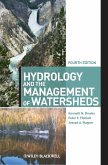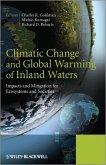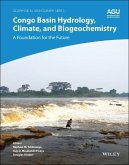Mathematical Models
Herausgegeben von Tanguy, Jean-Michel
Mathematical Models
Herausgegeben von Tanguy, Jean-Michel
- Gebundenes Buch
- Merkliste
- Auf die Merkliste
- Bewerten Bewerten
- Teilen
- Produkt teilen
- Produkterinnerung
- Produkterinnerung
This series of five volumes proposes an integrated description of physical processes modeling used by scientific disciplines from meteorology to coastal morphodynamics. Volume 1 describes the physical processes and identifies the main measurement devices used to measure the main parameters that are indispensable to implement all these simulation tools. Volume 2 presents the different theories in an integrated approach: mathematical models as well as conceptual models, used by all disciplines to represent these processes. Volume 3 identifies the main numerical methods used in all these…mehr
Andere Kunden interessierten sich auch für
![Practical Applications in Engineering Practical Applications in Engineering]() Practical Applications in Engineering254,99 €
Practical Applications in Engineering254,99 €![Modeling Software Modeling Software]() Modeling Software195,99 €
Modeling Software195,99 €![Physical Processes and Measurement Devices Physical Processes and Measurement Devices]() Physical Processes and Measurement Devices254,99 €
Physical Processes and Measurement Devices254,99 €![Numerical Methods Numerical Methods]() Numerical Methods254,99 €
Numerical Methods254,99 €![Hydrology Management Watershed Hydrology Management Watershed]() Kenneth N. BrooksHydrology Management Watershed117,99 €
Kenneth N. BrooksHydrology Management Watershed117,99 €![Climatic Change and Global Warming of Inland Waters Climatic Change and Global Warming of Inland Waters]() Climatic Change and Global Warming of Inland Waters155,99 €
Climatic Change and Global Warming of Inland Waters155,99 €![Congo Basin Hydrology, Climate, and Biogeochemistry Congo Basin Hydrology, Climate, and Biogeochemistry]() Congo Basin Hydrology, Climate, and Biogeochemistry228,99 €
Congo Basin Hydrology, Climate, and Biogeochemistry228,99 €-
-
-
This series of five volumes proposes an integrated description of physical processes modeling used by scientific disciplines from meteorology to coastal morphodynamics. Volume 1 describes the physical processes and identifies the main measurement devices used to measure the main parameters that are indispensable to implement all these simulation tools. Volume 2 presents the different theories in an integrated approach: mathematical models as well as conceptual models, used by all disciplines to represent these processes. Volume 3 identifies the main numerical methods used in all these scientific fields to translate mathematical models into numerical tools. Volume 4 is composed of a series of case studies, dedicated to practical applications of these tools in engineering problems. To complete this presentation, volume 5 identifies and describes the modeling software in each discipline.
Hinweis: Dieser Artikel kann nur an eine deutsche Lieferadresse ausgeliefert werden.
Hinweis: Dieser Artikel kann nur an eine deutsche Lieferadresse ausgeliefert werden.
Produktdetails
- Produktdetails
- ISTE .2
- Verlag: Wiley & Sons
- 1. Auflage
- Seitenzahl: 512
- Erscheinungstermin: 15. November 2010
- Englisch
- Abmessung: 231mm x 155mm x 36mm
- Gewicht: 1010g
- ISBN-13: 9781848211544
- ISBN-10: 1848211546
- Artikelnr.: 29932597
- Herstellerkennzeichnung
- Libri GmbH
- Europaallee 1
- 36244 Bad Hersfeld
- gpsr@libri.de
- ISTE .2
- Verlag: Wiley & Sons
- 1. Auflage
- Seitenzahl: 512
- Erscheinungstermin: 15. November 2010
- Englisch
- Abmessung: 231mm x 155mm x 36mm
- Gewicht: 1010g
- ISBN-13: 9781848211544
- ISBN-10: 1848211546
- Artikelnr.: 29932597
- Herstellerkennzeichnung
- Libri GmbH
- Europaallee 1
- 36244 Bad Hersfeld
- gpsr@libri.de
Jean-Michel Tanguy, Ministry of Sustainable Development, France.
Introduction xix
Jean-Michel TANGUY
Chapter 1. Reminders on the Mechanical Properties of Fluids 1
Jacques GEORGE
1.1. Laws of conservation, principles and general theorems 1
1.2. Enthalpy, rotation, mixing, saturation 13
1.3. Thermodynamic relations, relations of state and laws of behavior 20
1.4. Turbulent flow 26
1.5. Dynamics of geophysical fluids 30
Chapter 2. 3D Navier-Stokes Equations 35
Véronique DUCROCQ
2.1. The continuity hypothesis 35
2.2. Lagrangian description/Eulerian description 36
2.3. The continuity equation 37
2.4. The movement quantity assessment equation 38
2.5. The energy balance equation 41
2.6. The equation of state 41
2.7. Navier-Stokes equations for a fluid in rotation 41
Chapter 3. Models of the Atmosphere 43
Jean COIFFIER
3.1. Introduction 43
3.2. The various simplifications and corresponding models 44
3.3. The equations with various systems of coordinates 56
3.4. Some typical conformal projections 61
3.5. The operational models 67
3.6. Bibliography 69
Chapter 4. Hydrogeologic Models 71
Dominique THIÉRY
4.1. Equation of fluid mechanics 71
4.2. Continuity equation in porous media 72
4.3. Navier-Stokes' equations 74
4.4. Darcy's law 76
4.5. Calculating mass storage from the equations of state 80
4.6. General equation of hydrodynamics in porous media 82
4.7. Flows in unsaturated media 84
4.8. Bibliography 91
Chapter 5. Fluvial and Maritime Currentology Models 93
Jean-Michel TANGUY
5.1. 3D hydrostatic model 99
5.2. 2D horizontal model for shallow water 107
5.3. 1D models of fluvial flows 119
5.4. Putting 1D models into real time 131
5.5. Bibliography 151
Chapter 6. Urban Hydrology Models 155
Bernard CHOCAT
6.1. Global models and detailed models used in surface flows 156
6.2. Rainfall representation and rainfall-flow transformation 161
6.3. Modeling of the losses into the ground 164
6.4. Transfer function 169
6.5. Modeling of the hydraulic operating conditions of the networks 177
6.6. Production and transport of polluting agents 189
6.7. Conclusion 205
6.8. Bibliography 206
Chapter 7. Tidal Model and Tide Streams 213
Bernard SIMON
7.1. Tidal coefficient 214
7.2. Non-harmonic methods 215
7.3. Compatibilities 216
7.4. Tidal coefficient 222
7.5. Modeling 223
7.6. Tidal currents 226
Chapter 8. Wave Generation and Coastal Current Models 235
Jean-Michel TANGUY, Jean-Michel LEFÈVRE and Philippe SERGENT
8.1. Types of swell models 235
8.2. Spectral approach in high waters 242
8.3. Wave generation models 246
8.4. Wave propagation models 260
8.5. Agitating models within the harbors 266
8.6. Non-linear wave model: Boussinesq model 298
8.7. Coastal current models influenced or created by the swell 320
8.8. Bibliography 325
Chapter 9. Solid Transport Models and Evolution of the Seabed 335
Benoît LE GUENNEC and Jean-Michel TANGUY
9.1. Transport due to the overthrust effect 338
9.2. Total load 344
9.3. Bed forms and roughness 344
9.4. Suspension transport 346
9.5. Evolution model of movable beds 357
9.6. Conclusion 364
9.7. Bibliography 364
Chapter 10. Oil Spill Models 371
Pierre DANIEL
10.1. Behavior of hydrocarbons in marine environment 371
10.2. Oil spill drift models 372
10.3. Example: the MOTHY model 375
10.4. Calculation algorithm of the path of polluting particles 378
10.5. Example of a drift prediction map 379
10.6. Bibliography 379
Chapter 11. Conceptual, Empirical and Other Models 381
Christelle ALOT and Florence HABETS
11.1. Evapotranspiration 382
11.2. Bibliography 394
Chapter 12. Reservoir Models in Hydrology 397
Patrick FOURMIGUÉ and Patrick ARNAUD
12.1. Background 397
12.2. Main principles 399
12.3. Mathematical tools 401
12.4. Forecasting 403
12.5. Integration of the spatial information 405
12.6. Modeling limits 406
12.7. Bibliography 406
Chapter 13. Reservoir Models in Hydrogeology 409
Dominique THIÉRY
13.1. Principles and objectives 409
13.2. Catchment basin 410
13.3. Setting the model up 411
13.4. Data and parameters 412
13.5. Application domains 412
Chapter 14. Artificial Neural Network Models 419
Anne JOHANNET
14.1. Neural networks: a rapidly changing domain 420
14.2. Neuron and architecture models 422
14.3. How to take into account the non-linearity 429
14.4. Case study: identification of the rainfall-runoff relation of a karst
434
14.5. Acknowledgments 441
14.6. Bibliography 441
Chapter 15. Model Coupling 445
Rachid ABABOU, Denis DARTUS and Jean-Michel TANGUY
15.1. Model coupling 446
15.2. Bibliography 488
Chapter 16. A Set of Hydrological Models 493
Charles PERRIN, Claude MICHEL and Vasken ANDRÉASSIAN
16.1. Introduction 493
16.2. Description of the annual GR1A rainfall-runoff model 495
16.3. Description of the monthly GR2M rainfall-runoff model 496
16.4. Description of the daily GR4J rainfall-runoff model 500
16.5. Applications of the models 505
16.6. Conclusions and future work 506
16.7. Bibliography 507
List of Authors 511
Index 515
General Index of Authors 517
Summary of the Other Volumes in the Series 519
Jean-Michel TANGUY
Chapter 1. Reminders on the Mechanical Properties of Fluids 1
Jacques GEORGE
1.1. Laws of conservation, principles and general theorems 1
1.2. Enthalpy, rotation, mixing, saturation 13
1.3. Thermodynamic relations, relations of state and laws of behavior 20
1.4. Turbulent flow 26
1.5. Dynamics of geophysical fluids 30
Chapter 2. 3D Navier-Stokes Equations 35
Véronique DUCROCQ
2.1. The continuity hypothesis 35
2.2. Lagrangian description/Eulerian description 36
2.3. The continuity equation 37
2.4. The movement quantity assessment equation 38
2.5. The energy balance equation 41
2.6. The equation of state 41
2.7. Navier-Stokes equations for a fluid in rotation 41
Chapter 3. Models of the Atmosphere 43
Jean COIFFIER
3.1. Introduction 43
3.2. The various simplifications and corresponding models 44
3.3. The equations with various systems of coordinates 56
3.4. Some typical conformal projections 61
3.5. The operational models 67
3.6. Bibliography 69
Chapter 4. Hydrogeologic Models 71
Dominique THIÉRY
4.1. Equation of fluid mechanics 71
4.2. Continuity equation in porous media 72
4.3. Navier-Stokes' equations 74
4.4. Darcy's law 76
4.5. Calculating mass storage from the equations of state 80
4.6. General equation of hydrodynamics in porous media 82
4.7. Flows in unsaturated media 84
4.8. Bibliography 91
Chapter 5. Fluvial and Maritime Currentology Models 93
Jean-Michel TANGUY
5.1. 3D hydrostatic model 99
5.2. 2D horizontal model for shallow water 107
5.3. 1D models of fluvial flows 119
5.4. Putting 1D models into real time 131
5.5. Bibliography 151
Chapter 6. Urban Hydrology Models 155
Bernard CHOCAT
6.1. Global models and detailed models used in surface flows 156
6.2. Rainfall representation and rainfall-flow transformation 161
6.3. Modeling of the losses into the ground 164
6.4. Transfer function 169
6.5. Modeling of the hydraulic operating conditions of the networks 177
6.6. Production and transport of polluting agents 189
6.7. Conclusion 205
6.8. Bibliography 206
Chapter 7. Tidal Model and Tide Streams 213
Bernard SIMON
7.1. Tidal coefficient 214
7.2. Non-harmonic methods 215
7.3. Compatibilities 216
7.4. Tidal coefficient 222
7.5. Modeling 223
7.6. Tidal currents 226
Chapter 8. Wave Generation and Coastal Current Models 235
Jean-Michel TANGUY, Jean-Michel LEFÈVRE and Philippe SERGENT
8.1. Types of swell models 235
8.2. Spectral approach in high waters 242
8.3. Wave generation models 246
8.4. Wave propagation models 260
8.5. Agitating models within the harbors 266
8.6. Non-linear wave model: Boussinesq model 298
8.7. Coastal current models influenced or created by the swell 320
8.8. Bibliography 325
Chapter 9. Solid Transport Models and Evolution of the Seabed 335
Benoît LE GUENNEC and Jean-Michel TANGUY
9.1. Transport due to the overthrust effect 338
9.2. Total load 344
9.3. Bed forms and roughness 344
9.4. Suspension transport 346
9.5. Evolution model of movable beds 357
9.6. Conclusion 364
9.7. Bibliography 364
Chapter 10. Oil Spill Models 371
Pierre DANIEL
10.1. Behavior of hydrocarbons in marine environment 371
10.2. Oil spill drift models 372
10.3. Example: the MOTHY model 375
10.4. Calculation algorithm of the path of polluting particles 378
10.5. Example of a drift prediction map 379
10.6. Bibliography 379
Chapter 11. Conceptual, Empirical and Other Models 381
Christelle ALOT and Florence HABETS
11.1. Evapotranspiration 382
11.2. Bibliography 394
Chapter 12. Reservoir Models in Hydrology 397
Patrick FOURMIGUÉ and Patrick ARNAUD
12.1. Background 397
12.2. Main principles 399
12.3. Mathematical tools 401
12.4. Forecasting 403
12.5. Integration of the spatial information 405
12.6. Modeling limits 406
12.7. Bibliography 406
Chapter 13. Reservoir Models in Hydrogeology 409
Dominique THIÉRY
13.1. Principles and objectives 409
13.2. Catchment basin 410
13.3. Setting the model up 411
13.4. Data and parameters 412
13.5. Application domains 412
Chapter 14. Artificial Neural Network Models 419
Anne JOHANNET
14.1. Neural networks: a rapidly changing domain 420
14.2. Neuron and architecture models 422
14.3. How to take into account the non-linearity 429
14.4. Case study: identification of the rainfall-runoff relation of a karst
434
14.5. Acknowledgments 441
14.6. Bibliography 441
Chapter 15. Model Coupling 445
Rachid ABABOU, Denis DARTUS and Jean-Michel TANGUY
15.1. Model coupling 446
15.2. Bibliography 488
Chapter 16. A Set of Hydrological Models 493
Charles PERRIN, Claude MICHEL and Vasken ANDRÉASSIAN
16.1. Introduction 493
16.2. Description of the annual GR1A rainfall-runoff model 495
16.3. Description of the monthly GR2M rainfall-runoff model 496
16.4. Description of the daily GR4J rainfall-runoff model 500
16.5. Applications of the models 505
16.6. Conclusions and future work 506
16.7. Bibliography 507
List of Authors 511
Index 515
General Index of Authors 517
Summary of the Other Volumes in the Series 519
Introduction xix
Jean-Michel TANGUY
Chapter 1. Reminders on the Mechanical Properties of Fluids 1
Jacques GEORGE
1.1. Laws of conservation, principles and general theorems 1
1.2. Enthalpy, rotation, mixing, saturation 13
1.3. Thermodynamic relations, relations of state and laws of behavior 20
1.4. Turbulent flow 26
1.5. Dynamics of geophysical fluids 30
Chapter 2. 3D Navier-Stokes Equations 35
Véronique DUCROCQ
2.1. The continuity hypothesis 35
2.2. Lagrangian description/Eulerian description 36
2.3. The continuity equation 37
2.4. The movement quantity assessment equation 38
2.5. The energy balance equation 41
2.6. The equation of state 41
2.7. Navier-Stokes equations for a fluid in rotation 41
Chapter 3. Models of the Atmosphere 43
Jean COIFFIER
3.1. Introduction 43
3.2. The various simplifications and corresponding models 44
3.3. The equations with various systems of coordinates 56
3.4. Some typical conformal projections 61
3.5. The operational models 67
3.6. Bibliography 69
Chapter 4. Hydrogeologic Models 71
Dominique THIÉRY
4.1. Equation of fluid mechanics 71
4.2. Continuity equation in porous media 72
4.3. Navier-Stokes' equations 74
4.4. Darcy's law 76
4.5. Calculating mass storage from the equations of state 80
4.6. General equation of hydrodynamics in porous media 82
4.7. Flows in unsaturated media 84
4.8. Bibliography 91
Chapter 5. Fluvial and Maritime Currentology Models 93
Jean-Michel TANGUY
5.1. 3D hydrostatic model 99
5.2. 2D horizontal model for shallow water 107
5.3. 1D models of fluvial flows 119
5.4. Putting 1D models into real time 131
5.5. Bibliography 151
Chapter 6. Urban Hydrology Models 155
Bernard CHOCAT
6.1. Global models and detailed models used in surface flows 156
6.2. Rainfall representation and rainfall-flow transformation 161
6.3. Modeling of the losses into the ground 164
6.4. Transfer function 169
6.5. Modeling of the hydraulic operating conditions of the networks 177
6.6. Production and transport of polluting agents 189
6.7. Conclusion 205
6.8. Bibliography 206
Chapter 7. Tidal Model and Tide Streams 213
Bernard SIMON
7.1. Tidal coefficient 214
7.2. Non-harmonic methods 215
7.3. Compatibilities 216
7.4. Tidal coefficient 222
7.5. Modeling 223
7.6. Tidal currents 226
Chapter 8. Wave Generation and Coastal Current Models 235
Jean-Michel TANGUY, Jean-Michel LEFÈVRE and Philippe SERGENT
8.1. Types of swell models 235
8.2. Spectral approach in high waters 242
8.3. Wave generation models 246
8.4. Wave propagation models 260
8.5. Agitating models within the harbors 266
8.6. Non-linear wave model: Boussinesq model 298
8.7. Coastal current models influenced or created by the swell 320
8.8. Bibliography 325
Chapter 9. Solid Transport Models and Evolution of the Seabed 335
Benoît LE GUENNEC and Jean-Michel TANGUY
9.1. Transport due to the overthrust effect 338
9.2. Total load 344
9.3. Bed forms and roughness 344
9.4. Suspension transport 346
9.5. Evolution model of movable beds 357
9.6. Conclusion 364
9.7. Bibliography 364
Chapter 10. Oil Spill Models 371
Pierre DANIEL
10.1. Behavior of hydrocarbons in marine environment 371
10.2. Oil spill drift models 372
10.3. Example: the MOTHY model 375
10.4. Calculation algorithm of the path of polluting particles 378
10.5. Example of a drift prediction map 379
10.6. Bibliography 379
Chapter 11. Conceptual, Empirical and Other Models 381
Christelle ALOT and Florence HABETS
11.1. Evapotranspiration 382
11.2. Bibliography 394
Chapter 12. Reservoir Models in Hydrology 397
Patrick FOURMIGUÉ and Patrick ARNAUD
12.1. Background 397
12.2. Main principles 399
12.3. Mathematical tools 401
12.4. Forecasting 403
12.5. Integration of the spatial information 405
12.6. Modeling limits 406
12.7. Bibliography 406
Chapter 13. Reservoir Models in Hydrogeology 409
Dominique THIÉRY
13.1. Principles and objectives 409
13.2. Catchment basin 410
13.3. Setting the model up 411
13.4. Data and parameters 412
13.5. Application domains 412
Chapter 14. Artificial Neural Network Models 419
Anne JOHANNET
14.1. Neural networks: a rapidly changing domain 420
14.2. Neuron and architecture models 422
14.3. How to take into account the non-linearity 429
14.4. Case study: identification of the rainfall-runoff relation of a karst
434
14.5. Acknowledgments 441
14.6. Bibliography 441
Chapter 15. Model Coupling 445
Rachid ABABOU, Denis DARTUS and Jean-Michel TANGUY
15.1. Model coupling 446
15.2. Bibliography 488
Chapter 16. A Set of Hydrological Models 493
Charles PERRIN, Claude MICHEL and Vasken ANDRÉASSIAN
16.1. Introduction 493
16.2. Description of the annual GR1A rainfall-runoff model 495
16.3. Description of the monthly GR2M rainfall-runoff model 496
16.4. Description of the daily GR4J rainfall-runoff model 500
16.5. Applications of the models 505
16.6. Conclusions and future work 506
16.7. Bibliography 507
List of Authors 511
Index 515
General Index of Authors 517
Summary of the Other Volumes in the Series 519
Jean-Michel TANGUY
Chapter 1. Reminders on the Mechanical Properties of Fluids 1
Jacques GEORGE
1.1. Laws of conservation, principles and general theorems 1
1.2. Enthalpy, rotation, mixing, saturation 13
1.3. Thermodynamic relations, relations of state and laws of behavior 20
1.4. Turbulent flow 26
1.5. Dynamics of geophysical fluids 30
Chapter 2. 3D Navier-Stokes Equations 35
Véronique DUCROCQ
2.1. The continuity hypothesis 35
2.2. Lagrangian description/Eulerian description 36
2.3. The continuity equation 37
2.4. The movement quantity assessment equation 38
2.5. The energy balance equation 41
2.6. The equation of state 41
2.7. Navier-Stokes equations for a fluid in rotation 41
Chapter 3. Models of the Atmosphere 43
Jean COIFFIER
3.1. Introduction 43
3.2. The various simplifications and corresponding models 44
3.3. The equations with various systems of coordinates 56
3.4. Some typical conformal projections 61
3.5. The operational models 67
3.6. Bibliography 69
Chapter 4. Hydrogeologic Models 71
Dominique THIÉRY
4.1. Equation of fluid mechanics 71
4.2. Continuity equation in porous media 72
4.3. Navier-Stokes' equations 74
4.4. Darcy's law 76
4.5. Calculating mass storage from the equations of state 80
4.6. General equation of hydrodynamics in porous media 82
4.7. Flows in unsaturated media 84
4.8. Bibliography 91
Chapter 5. Fluvial and Maritime Currentology Models 93
Jean-Michel TANGUY
5.1. 3D hydrostatic model 99
5.2. 2D horizontal model for shallow water 107
5.3. 1D models of fluvial flows 119
5.4. Putting 1D models into real time 131
5.5. Bibliography 151
Chapter 6. Urban Hydrology Models 155
Bernard CHOCAT
6.1. Global models and detailed models used in surface flows 156
6.2. Rainfall representation and rainfall-flow transformation 161
6.3. Modeling of the losses into the ground 164
6.4. Transfer function 169
6.5. Modeling of the hydraulic operating conditions of the networks 177
6.6. Production and transport of polluting agents 189
6.7. Conclusion 205
6.8. Bibliography 206
Chapter 7. Tidal Model and Tide Streams 213
Bernard SIMON
7.1. Tidal coefficient 214
7.2. Non-harmonic methods 215
7.3. Compatibilities 216
7.4. Tidal coefficient 222
7.5. Modeling 223
7.6. Tidal currents 226
Chapter 8. Wave Generation and Coastal Current Models 235
Jean-Michel TANGUY, Jean-Michel LEFÈVRE and Philippe SERGENT
8.1. Types of swell models 235
8.2. Spectral approach in high waters 242
8.3. Wave generation models 246
8.4. Wave propagation models 260
8.5. Agitating models within the harbors 266
8.6. Non-linear wave model: Boussinesq model 298
8.7. Coastal current models influenced or created by the swell 320
8.8. Bibliography 325
Chapter 9. Solid Transport Models and Evolution of the Seabed 335
Benoît LE GUENNEC and Jean-Michel TANGUY
9.1. Transport due to the overthrust effect 338
9.2. Total load 344
9.3. Bed forms and roughness 344
9.4. Suspension transport 346
9.5. Evolution model of movable beds 357
9.6. Conclusion 364
9.7. Bibliography 364
Chapter 10. Oil Spill Models 371
Pierre DANIEL
10.1. Behavior of hydrocarbons in marine environment 371
10.2. Oil spill drift models 372
10.3. Example: the MOTHY model 375
10.4. Calculation algorithm of the path of polluting particles 378
10.5. Example of a drift prediction map 379
10.6. Bibliography 379
Chapter 11. Conceptual, Empirical and Other Models 381
Christelle ALOT and Florence HABETS
11.1. Evapotranspiration 382
11.2. Bibliography 394
Chapter 12. Reservoir Models in Hydrology 397
Patrick FOURMIGUÉ and Patrick ARNAUD
12.1. Background 397
12.2. Main principles 399
12.3. Mathematical tools 401
12.4. Forecasting 403
12.5. Integration of the spatial information 405
12.6. Modeling limits 406
12.7. Bibliography 406
Chapter 13. Reservoir Models in Hydrogeology 409
Dominique THIÉRY
13.1. Principles and objectives 409
13.2. Catchment basin 410
13.3. Setting the model up 411
13.4. Data and parameters 412
13.5. Application domains 412
Chapter 14. Artificial Neural Network Models 419
Anne JOHANNET
14.1. Neural networks: a rapidly changing domain 420
14.2. Neuron and architecture models 422
14.3. How to take into account the non-linearity 429
14.4. Case study: identification of the rainfall-runoff relation of a karst
434
14.5. Acknowledgments 441
14.6. Bibliography 441
Chapter 15. Model Coupling 445
Rachid ABABOU, Denis DARTUS and Jean-Michel TANGUY
15.1. Model coupling 446
15.2. Bibliography 488
Chapter 16. A Set of Hydrological Models 493
Charles PERRIN, Claude MICHEL and Vasken ANDRÉASSIAN
16.1. Introduction 493
16.2. Description of the annual GR1A rainfall-runoff model 495
16.3. Description of the monthly GR2M rainfall-runoff model 496
16.4. Description of the daily GR4J rainfall-runoff model 500
16.5. Applications of the models 505
16.6. Conclusions and future work 506
16.7. Bibliography 507
List of Authors 511
Index 515
General Index of Authors 517
Summary of the Other Volumes in the Series 519








